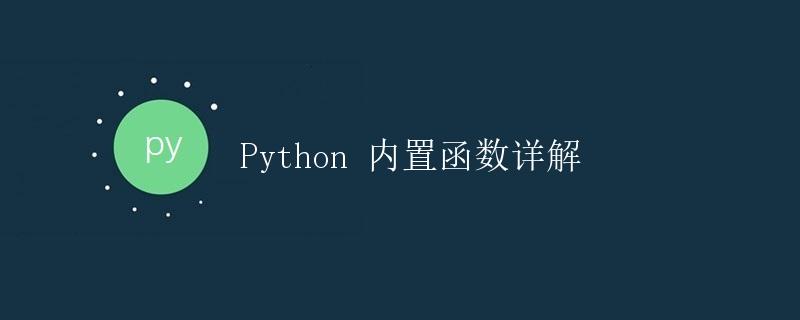Python 内置函数详解

1. 引言
在 Python 中,有许多内置的函数可用于执行各种任务。这些内置函数是 Python 解释器中的一部分,无需导入任何模块即可直接使用。本文将详细介绍一些常用的内置函数,并提供示例代码和运行结果。
2. 内置函数列表
下面是一些常用的 Python 内置函数:
print(): 打印输出信息。len(): 返回对象的长度或元素个数。type(): 返回对象的类型。int(): 将一个对象转换为整数。float(): 将一个对象转换为浮点数。str(): 将一个对象转换为字符串。list(): 将一个可迭代对象转换为列表。dict(): 创建一个字典或将可迭代对象转换为字典。set(): 创建一个集合或将可迭代对象转换为集合。range(): 创建一个指定范围的整数序列。input(): 获取用户输入。
3. 示例代码
3.1. print()
print() 函数用于将指定的对象打印到标准输出。可以传入多个对象,并用逗号分隔。示例代码如下:
print("Hello, world!")
print("The answer is", 42)
运行结果:
Hello, world!
The answer is 42
3.2. len()
len() 函数返回指定对象的长度或元素个数。它适用于字符串、列表、元组、字典、集合等。示例代码如下:
s = "Hello, world!"
print(len(s)) # 输出:13
lst = [1, 2, 3, 4, 5]
print(len(lst)) # 输出:5
d = {"name": "Alice", "age": 20}
print(len(d)) # 输出:2
运行结果:
13
5
2
3.3. type()
type() 函数返回指定对象的类型。示例代码如下:
s = "Hello, world!"
print(type(s)) # 输出:<class 'str'>
x = 42
print(type(x)) # 输出:<class 'int'>
lst = [1, 2, 3, 4, 5]
print(type(lst)) # 输出:<class 'list'>
运行结果:
<class 'str'>
<class 'int'>
<class 'list'>
3.4. int()
int() 函数将指定的对象转换为整数。如果对象是浮点数或字符串,它将被转换为整数;如果对象是其他类型,将引发 TypeError。示例代码如下:
x = 42.5
print(int(x)) # 输出:42
s = "123"
print(int(s)) # 输出:123
lst = [1, 2, 3, 4, 5]
print(int(lst)) # 引发 TypeError
运行结果:
42
123
Traceback (most recent call last):
File "<stdin>", line 5, in <module>
TypeError: int() argument must be a string, a bytes-like object or a number, not 'list'
3.5. float()
float() 函数将指定的对象转换为浮点数。如果对象是整数或字符串,它将被转换为浮点数;如果对象是其他类型,将引发 TypeError。示例代码如下:
x = 42
print(float(x)) # 输出:42.0
s = "3.14"
print(float(s)) # 输出:3.14
lst = [1, 2, 3, 4, 5]
print(float(lst)) # 引发 TypeError
运行结果:
42.0
3.14
Traceback (most recent call last):
File "<stdin>", line 5, in <module>
TypeError: float() argument must be a string or a number, not 'list'
3.6. str()
str() 函数将指定的对象转换为字符串。示例代码如下:
x = 42
print(str(x)) # 输出:"42"
lst = [1, 2, 3, 4, 5]
print(str(lst)) # 输出:"[1, 2, 3, 4, 5]"
d = {"name": "Alice", "age": 20}
print(str(d)) # 输出: "{'name': 'Alice', 'age': 20}"
运行结果:
42
[1, 2, 3, 4, 5]
{'name': 'Alice', 'age': 20}
3.7. list()
list() 函数用于将可迭代对象转换为列表。示例代码如下:
s = "Hello"
lst = list(s)
print(lst) # 输出:['H', 'e', 'l', 'l', 'o']
t = (1, 2, 3, 4, 5)
lst = list(t)
print(lst) # 输出:[1, 2, 3, 4, 5]
运行结果:
['H', 'e', 'l', 'l', 'o']
[1, 2, 3, 4, 5]
3.8. dict()
dict() 函数用于创建字典或将可迭代对象转换为字典。示例代码如下:
d = dict() # 创建一个空字典
print(d) # 输出:{}
lst = [("name", "Alice"), ("age", 20)]
d = dict(lst)
print(d) # 输出:{'name': 'Alice', 'age': 20}
运行结果:
{}
{'name': 'Alice', 'age': 20}
3.9. set()
set() 函数用于创建集合或将可迭代对象转换为集合。示例代码如下:
s = set() # 创建一个空集合
print(s) # 输出:set()
lst = [1, 2, 2, 3, 3, 3, 4, 5]
s = set(lst)
print(s) # 输出:{1, 2, 3, 4, 5}
运行结果:
set()
{1, 2, 3, 4, 5}
3.10. range()
range() 函数用于创建一个指定范围的整数序列。示例代码如下:
r = range(5)
print(list(r)) # 输出:[0, 1, 2, 3, 4]
r = range(1, 6)
print(list(r)) # 输出:[1, 2, 3, 4, 5]
r = range(1, 10, 2)
print(list(r)) # 输出:[1, 3, 5, 7, 9]
 极客教程
极客教程